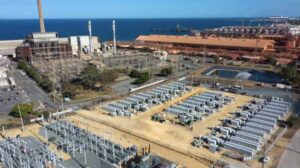EnergyAustralia, one of the big three energy “gentailers” in Australia, says its profits in the first half of 2020 fell around 20 per cent because of the fall in wholesale prices and the impact of Covid-19, but it is looking to invest up to 1,000MW of new gas fired generation as part of its efforts to support the transition to renewables.
EnergyAustralia released its results late Monday at the same time as those of its Hong-Kong based owner CLP, which noted that its overall earnings were more or less in line with the previous corresponding period but for the “markedly lower” returns from Australia.
However, while EA’s earnings before interest and tax were down 20 per cent to $A253 million, a non-cash revaluation of its hedge portfolio in Australia boosted that division’s overall operating results by 45 per cent, and helped CLP deliver an overall 12 per cent lift in its earnings for the half.
“Financially, we reported operating earnings of $HK6.1 billion, an increase of 12% when compared with the first half of last year. This was driven by a significant turnaround in fair value adjustments in Australia,” CEO Richard Lancaster told an analysts briefing.
EA’s results were impacted by price regulation and intense retail competition, which led to a three per cent reduction of customer accounts and electricity sales were further impacted by COVID-19. “We’ve continued to decarbonise our generation portfolio, adding renewable energy projects in India and China, while expanding gas generation capacity at Black Point in Hong Kong and Hallett in Australia,” Lancaster said.
EA boss Catherine Tanna noted the company has signed up to take the output of the proposed Kidston pumped hydro project in north Queensland, expected to come into service by 2024 with a capacity of 250MW and eight hours storage, but the rest of its focus on dispatchable generation would be on gas.
Apart from the recent 30MW Hallett upgrade, it is considering expanding its Tallawarre facility in NSW – by up to about 400MW – and is looking at a total of up to 1,000MW in new fast-response gas generation capacity to support the clean energy transition.
(It recently argued against a delay to the 5-minute settlement period that will favour fast start generators and battery storage technologies. It also contracts the output of the Gannawarra and Ballarat battery storage installations in Victoria).
CLP said any decision on Tallawarra would take into account the “many, many variables” that include the amount of wind projects, the expected price volatility in peak and off-peak, the gas price and the anticipated returns across a 20-year investment,
Tanna, until recently, was a member of the government’s Covid taskforce that has focused heavily on gas, and the CLP press release also spoke in support of the federal government’s Technology Roadmap, which also puts a heavy emphasis on the need for gas as a key transition fuel.
EnergyAustralia also owns the Yallourn brown coal generator in Victoria and the Mt Piper coal plant in NSW. Yallourn, due to begin closing units from 2029, is expected to undertake significant upgrade at its number 2 unit this year, and its number 1 unit in 2021. It had an unplanned outage at Mt Piper due to boiler issues in March but has secured long term coal supply contracts. It plans more maintenance at that plant this year.
Asked about the future of the Australian business, Lancaster said the company had been involved in the local market for 15 years and saw value in keeping it.
“It is a changing market. It’s going through an energy transition,” Lancaster said. “It has very complex and fast-moving regulation. And we have been adapting to that over the past few years. We have had an exercise in value restoration, and that is continuing.
“We are still looking to extract value from that business. Part of that is looking at taking advantage of our scale, but it does require us to make investments in the IT side of our business so that we can become more competitive longer term. So fundamentally, we still believe that our business is in strong shape there. But we are looking at specific programs of cost reduction and continuing to do so.”
Asked specifically about Yallourn, and market speculation that it could close earlier than 2032 (under current forecasts some units may close in 2029 but the last ones in 2032), Lancaster responded:
“At the moment, Yallourn has an operating license to run to 2032. And if it was to reach its natural retirement age, it would run all the way to 2032.
“Yallourn provides a significant portion of Victoria’s generating capacity. In order for Yallourn to be closed down, there needs to be replacement capacity developed and there needs to be a plan developed with both the Victorian government and also the local government to deal with the economic impact in the Latrobe Valley.
“So a lot of considerations and a lot of discussion between EnergyAustralia and the Victorian government would be needed if that plan was to be brought forward.”
In a separate statement, Tanna said that the first half had been a “cruel and challenging year for Australia” and many customers had suffered. But she pointed to the recent announcement of lower prices for customers in New South Wales, South Australia, Queensland and the Australian Capital Territory, reflecting lower wholesale electricity prices.
“If anyone is struggling with a power bill, please – don’t let the issue build up,” Tanna said. “Get in touch. While a customer is participating in our hardship program their lights will always stay on with our stay-connected guarantee.”









